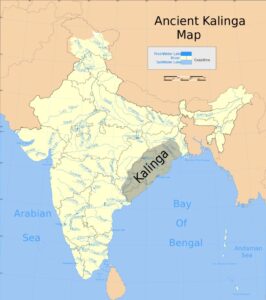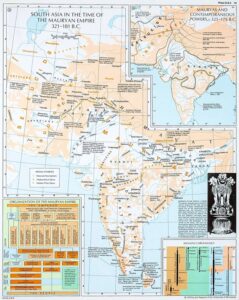Introduction
One of the greatest kings in Indian history was Ashoka the Great. In Ashoka’s life, the Kalinga War marked a turning point. He was upset to witness so much carnage and ruin throughout that conflict. He was highly affected by Buddhist doctrine and abandoned all forms of violence. Furthermore, he advocated the “Dhamma” policy, which accepted the tenets of Buddhism, while keeping in mind non-violence and compassion. The Sanskrit term “Dharma,” which denotes religious and moral obligation, is the root of the word “dhamma.” For all living things to coexist happily on this planet, Ashoka intended to propagate good moral ideals among the populace through this policy.

The Dhamma Policy of Ashoka
After the Kalinga War, Ashoka became a Buddhist and began to follow and propagate Buddhist ideas. In addition, he developed a new “dhamma” policy that emphasised non-violence, compassion, and peace.
- He never made a big deal out of any complicated sacrifices or rites in this. After that, he gave up on his plan to conquer more territory and subjugate other cultures.
- He decided to become “Dhamma Mahamatta,” a travelling preacher of the Dhamma, to spread its teachings throughout his empire. Even his son and daughter were dispatched to Sri Lanka to propagate the Dhamma.
- Secularism, which did not focus on any single religion but rather respected all religions, was the foundation of his Dhamma. He never forced the Dhamma on his subjects; instead, they were persuaded and came to accept it.
- He set an example for others to follow by adhering to this policy himself in a very strict manner. On numerous rocks and structures, he carved his edicts in languages used by regular people. So that everyone living in his empire might read, comprehend, and apply the “Dhamma” to their daily life.
Dhamma of Ashoka’s Principles
The Buddha’s teachings served as an inspiration for Ashoka’s Dhamma. His Dhamma’s concepts were quite straightforward and easily understood by the populace. Ashoka was more interested in using persuasion than regulation and imposition to spread this policy. The guiding concepts of his strategy are as follows:
- Ashoka wished for his followers to adhere to the non-violence, or ahimsa concept toward all living things, including people and animals. To strengthen the Empire at the time, which was quite common, he abandoned the idea of war for territorial expansion. Additionally, he preached against harming or killing animals.
- Respect for parents and other adults: He counselled kids to always respect and obey their parents and other adults. Similarly, parents and elders are required to be compassionate and kind toward their young charges.
- He emphasised the need for us to exhibit generosity toward everyone by choosing the way of kindness, love, harmony, and respect. He recommended charitable giving to the poor and turn toward slaves, servants, and animals to achieve this. Respect should be shown for one another. We shouldn’t abuse our position and influence. Instead, we ought to think about how we may be kind to others.
- He proclaimed via his Dhamma that one should appreciate those who practise different religions. He did not advocate joining a specific religion or turning to a specific deity. Furthermore, he granted everyone in his kingdom the freedom to follow their principles and to live their lives as they saw fit, and he vowed that the government would never force a specific religion on its people. Additionally, he favoured peaceful coexistence among all races, religions, and creeds. His goal was to create harmonious relationships between many aspects of society to eventually unite the populace behind shared values and rule a tranquil, huge empire.
Summary
The Dhamma of Ashoka was mostly derived from Buddhist teachings. After the Kalinga conflict, he implemented this policy, which caused the loss of many lives and left him feeling guilty, and sorry for himself. He was able to keep his empire pleasant and harmonious by using the Dhamma. In a sense, he was able to eradicate socio-political instability in his empire by upholding the values of mutual kindness, respect for all religious beliefs, compliance with authority figures, and consideration for younger people. He also rejected superstitious practices and advocated for ahimsa. In essence, he created a secular and liberal empire with this approach, freeing him from the necessity to impose a particular faith on his subjects.
Frequently Asked Questions
1.Why did Ashoka and Kalinga Fight?
Ans: Kalinga, now Odisha, was a powerful maritime nation. The power might open up commercial opportunities for the Mauryan Empire with nations in Southeast Asia. Ashoka, therefore, desired to incorporate that country within his empire.
2.Why was Ashoka referred to as “Ashoka the Great”?
Ans: One of the kings who became known as the greatest king in Indian history was Ashoka. This was a result of his distinct management style, which allowed him to oversee such a sizable empire while preventing any physical injury to anyone.
3.How does Ashoka’s Dhamma still have value in Modern Society?
Ans: Yes, Ashoka’s Dhamma principle—which advocated a moral way of life centred on showing respect for all living things—is still very much important in today’s culture. It also emphasised the need for tolerance, which is essential for surviving in a nation as varied and multi-religious as India.


